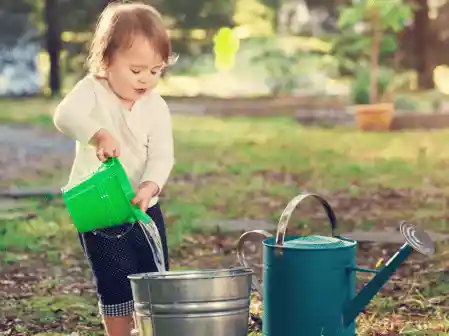Spring into Play! Refresh Outdoor Spaces

Spring into Play! Refreshing Your Outdoor Space for New Adventures
Flowers are popping up from the earth, birds sing and hunt for worms, the days are stretching with sunshine seeping later into the day. Spring is on its way, along with more opportunities to bring play and learning outdoors. There’s no better time to give your outdoor play spaces a refresh! After a long winter, our outdoor spaces often need some care and attention. Here are a few helpful tips to make sure your space is safe, engaging, and ready for new adventures!
Safety First
Planting and play invitations might be the most colorful places to begin, but don’t overlook these safety reminders:
-
Inspect equipment, fences, pathways, and materials: Make sure everything is sturdy and in good repair.
-
Refresh your resilient surfaces: Check your mulch, sand and rubber mats and remove any debris or hazards.
-
Assess tools and storage spaces: Confirm that sheds, toy bins, and gardening tools are in good condition. Replace broken or worn-out materials.
-
Get organized: Assess toys, sensory materials, and other outdoor necessities. Remove anything in poor repair and give everything a good cleaning. Rotate materials to refresh play areas.
-
Remember to check your program’s policies and state licensing requirements for safety guidelines.
Garden Glow-up
Modeling attention and care to your play areas helps children learn to care for and appreciate nature. No need for huge changes! Small seasonal additions to gardens, flower beds, and play spaces spark curiosity and invite learning.
-
Tidy up the landscape: Remove dead foliage, trim overgrown plants, and prepare areas for new growth.
-
Plant with purpose: Choose child-friendly plants like sunflowers, herbs, and vegetables that children can help care for.
-
Incorporate natural elements: Logs, stumps and large stones create wonderful loose parts for climbing, balancing and imaginative play.
-
Invite children’s creativity: Painted stones or garden signs are helpful to mark the location of newly planted seeds or fragile seedlings.
-
Short on space? Raised beds or container gardens are convenient solutions to add natural elements and help children experience plant lifecycles firsthand.
-
Create a pollinator paradise: Plant a butterfly garden or add a birdhouse. Keep a tote with clipboards or nature journals for children to record their observations of animals in their habitats.
Extend Play and Learning with Mobile Materials
Whether your setting has expansive outdoor spaces or shares public play areas, there are lots of ways to keep materials for outdoor adventures close at hand.
-
Wagons, carts, totes and baskets are your best friend! Materials will stay grouped together and ready to be where the action is!
-
Science investigations and the outdoors go hand in hand. Magnifying glasses, insect viewers, scales and balances, ramps, and channels, and don’t forget simple machines! Learning opportunities abound as real-life and hands-on observations and experiments unfold.
-
Stress-free messy play: Clay, paint, sensory materials, and water play are important parts of indoor environments, but taking traditionally messy activities outside can relieve some of the stress and a lot of the cleanup. Don’t forget classic outdoor options like sidewalk chalk or painting with water. Outdoor creative exploration can be simple and engaging when the world is a canvas.
-
Big possibilities with loose parts: Introduce materials that children can move, combine, and repurpose in different ways. Tree cookies, branches, cardboard boxes, crates, and planks encourage building and imaginative play. Add color and texture to fabric, scarves, or ribbons.
Cultivate Community
Your program’s outdoor space is the perfect place to nurture connections to families and the wider community.
-
Consider outdoor arrival and departure routines: Children sometimes have an easier time transitioning to their school day when morning drop off takes place outside. End-of-day pick-up in your outdoor space can encourage teacher-child conversation, family connection, and relaxed time for children and parents to reconnect.
-
Invite guest experts: Local specialists are often willing to come to schools to share their expertise, and a comfortable outdoor space is the perfect place to host their visit. Check out your local environmental councils, wildlife specialists, master gardening clubs, higher education centers and other community resources.
-
Coordinate a Spring Cleanup Day with families: Encourage families to come help with a shared outdoor work session. Keep it short with clearly defined tasks, then wrap up with a fun shared activity, like a scavenger hunt and picnic.
Spring is all about fresh starts, and your outdoor play space is ready for one too! A little sprucing up will make your area inviting and encourage renewed exploration and adventure.
So, what’s one thing you can do to refresh your outdoor play space this season? Grab your rake, some loose parts, or a packet of seeds, and let’s get started!
Resources
WEBINAR: Supporting Children’s Social-Emotional Learning Through Play

Christine Murray is an Early Childhood Education Specialist with Becker’s Education Team.
As an educator, coach and leader, Christine is inspired by the curiosity, joy and wonder that children so generously model for us. She earned her M.A. in Innovative Early Childhood Education at the University of Colorado Denver and loves collaborating with and supporting others in the field. Grounded in relationships and guided by empathy, Christine is always learning, connecting and creating.
